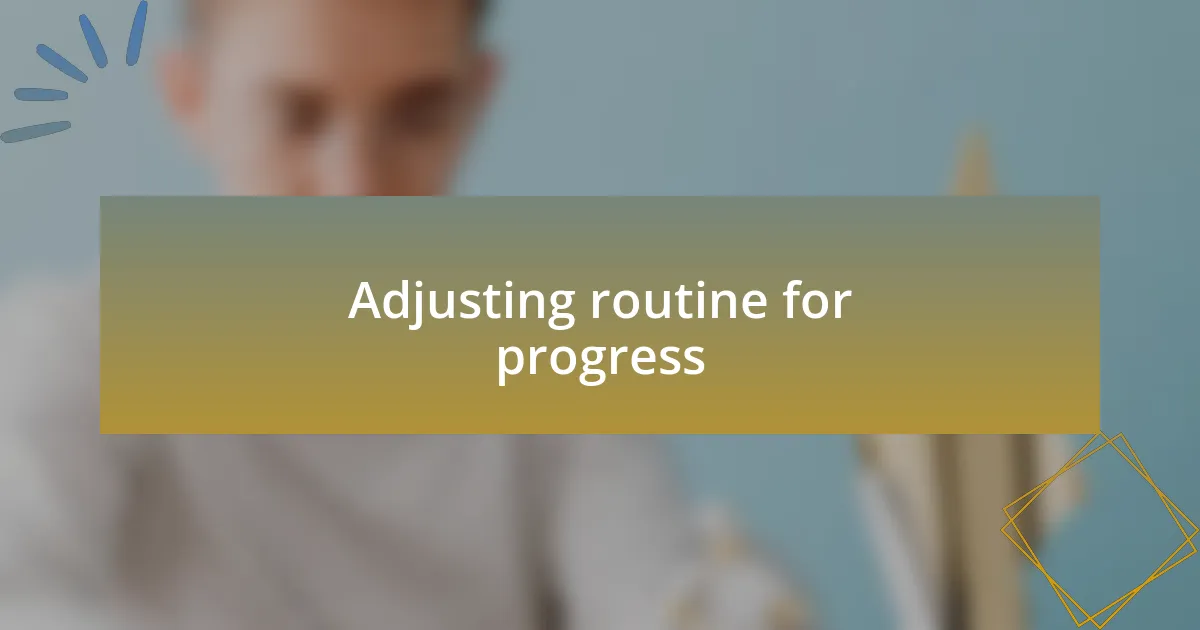Key takeaways:
- Creating a personal exercise routine requires alignment with individual goals, preferences, and lifestyle for long-term success.
- Setting SMART goals and celebrating small milestones enhances motivation and keeps workouts engaging.
- A structured workout plan allows for targeted training, progress tracking, and adaptability to life changes, making fitness manageable.
- Maintaining motivation through music, recognizing small victories, and partnering with a workout buddy can significantly enhance consistency.

Understanding personal exercise routines
Creating a personal exercise routine is like composing a song; it requires harmony between your goals, preferences, and lifestyle. When I first started, I felt overwhelmed by all the options—cardio, strength training, yoga—and I had to ask myself, “What truly resonates with me?” Reflecting on what I enjoyed helped tailor my routine in a way that felt less like a chore and more like my unique rhythm.
I remember the excitement mixing a variety of workouts, discovering which exercises made me feel energized versus drained. Initially, I would aim for a cookie-cutter routine, only to realize that the lack of joy was sapping my motivation. It was freeing to think, “Hey, I can swap out a run for dancing in my living room!” This realization transformed my approach; I learned that understanding what moves and motivates you is essential for long-term success.
As I refined my routine, I found that setting small milestones kept me engaged and eager to progress. Have you ever celebrated a little victory, like lifting a heavier weight or completing an extra set? Those moments create connections between the effort and the reward, fueling the journey. A personal exercise routine is not just about physical fitness; it’s about crafting a rewarding experience that resonates deeply, making each workout an anticipation rather than an obligation.

Importance of a structured workout
When I began structuring my workouts, I quickly realized the importance of organization. A structured workout helps in mapping out my progress and keeps me accountable. Have you ever noticed how much easier it is to stick to a plan when you can visually track your achievements? That sense of accomplishment can be incredibly motivating.
I’ve found that a well-defined routine also allows me to focus on specific muscle groups or skills during each session. For instance, dedicating one day to strength training and another to flexibility has not only improved my performance but also kept me injury-free. It’s like tuning an instrument; when I invest time in each part, I create a stronger, more balanced performance overall.
What often surprises me is how a structured approach can adapt to changes in my life. When work got hectic, I could easily shorten my routine but still target essential exercises. This adaptability has become crucial; it ensures that my commitment remains unwavering, even during busy times. Isn’t it reassuring to know that with a little structure, you can make fitness fit into your life instead of feeling like a burden?

Identifying your fitness goals
Identifying your fitness goals is a crucial first step in developing a routine that truly resonates with you. When I started, I had to ask myself what I wanted to achieve: was it weight loss, building muscle, or simply feeling more energetic? Reflecting on these questions helped me create a clearer vision of my fitness journey.
One memorable moment was when I realized that my initial goal of losing ten pounds wasn’t enough to sustain my motivation long-term. I shifted my focus toward building endurance, which made my workouts feel more purposeful. This change sparked a newfound love for running; I found joy in setting distance goals and celebrating every small victory. Have you ever noticed how a shift in perspective can ignite your passion?
As I tweaked my objectives, I learned the value of setting SMART goals—Specific, Measurable, Achievable, Relevant, and Time-Bound. This framework provided a roadmap and kept me on track. For example, rather than saying “I want to get fit,” I would declare, “I will run a 5K in three months.” Breaking my larger aspirations into bite-sized goals made the journey less daunting and more manageable. Have you thought about how precise goals could alter your fitness experience?

Creating a weekly exercise schedule
Creating a weekly exercise schedule can feel overwhelming at first, but I found that breaking it down made it manageable. I started by outlining my ideal week, considering my energy levels at different times. For instance, I realized I had the most motivation in the mornings, so I scheduled my most challenging workouts then. Have you thought about when your peak energy times are?
Once I had a basic outline, I added variety to keep things exciting. I mixed cardio days with strength training and even incorporated activities like yoga to enhance flexibility. I remember the thrill of trying a new fitness class midweek—it not only broke the monotony but also opened doors to social connections. How often do you step outside your comfort zone with your routine?
Lastly, I learned the importance of rest days through experience. In the beginning, I feared that rest would hinder my progress, but I soon discovered that allowing my body time to recover made me stronger in the long run. I now schedule a rest day every week, prioritizing mental and physical recovery. Have you considered how rest might play a role in your fitness journey?

Adjusting routine for progress
Adjusting your exercise routine is essential for making real progress. I remember a particularly frustrating week when my usual routine stopped yielding results. That was my wake-up call; I realized I had to analyze my workouts, track my progress, and tweak my regimen. Have you ever felt that your efforts just weren’t translating into improvements?
I distinctly recall the moment I decided to swap out a couple of exercises that weren’t challenging me anymore. The shift not only reignited my enthusiasm but also contributed to noticeable gains. This change reflected how I had to be proactive about my progress. Have you taken the time to evaluate whether certain exercises are really benefiting you?
As I continued refining my routine, I learned to embrace the ebb and flow of my motivation. On days when my energy dipped, instead of pushing through rigidly, I adapted by doing lighter activities or focusing more on flexibility. Finding that balance made my workouts enjoyable rather than a chore. How flexible are you with your exercise plan when your body needs something different?

Maintaining motivation and consistency
Staying motivated can sometimes feel like an uphill battle. I remember a phase when I started to drag my feet about exercise; it was as if my momentum had fizzled out. So, I decided to incorporate music into my workouts, creating playlists that resonated with my energy levels. It transformed my attitude entirely—suddenly, exercise became something I looked forward to rather than a chore. Have you tried using your favorite tracks to boost your motivation?
Consistency also plays a crucial role in maintaining motivation. During weeks when I felt overwhelmed, I focused on the smallest victories—like completing just a 15-minute workout. Those little wins accumulated over time, helping me stay on track even when motivation dipped. Have you celebrated your achievements, no matter how small they might seem?
Finding a workout buddy significantly changed my perspective on consistency. I remember planning sessions with a friend who held me accountable and made the experience enjoyable. Having someone to share the journey with brought an unexpected sense of camaraderie that not only kept me consistent but also made each exercise session feel less daunting. Do you have a partner to share your fitness goals with?